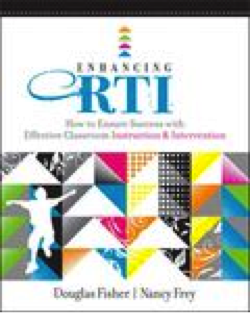RTI: Instruction First
Enhancing RTI: How to Ensure Success with Effective Classroom Instruction & Intervention
By Douglas Fisher and Nancy Frey
ASCD, 2010 – Learn more
It’s easy to get lured into Enhancing RTI: How to Ensure Success with Effective Classroom Instruction and Intervention, by Douglas Fisher and Nancy Frey.
Within the first few pages, the reader is asked to “choose an adventure” that begins with a brief profile of Adam, “a fifth grader in a public school somewhere in the United States.” His educational experience is put in the hands of the reader, as we decide which learning conditions will serve Adam best. It isn’t too difficult to figure out — so long as the reader has moved beyond the traditional teacher-centered, “students as passive learners”, mentality.
Authors Douglas Fisher and Nancy Frey combine their expertise to share knowledge and practical ways teachers can plan the learning experience within positive cycles of instruction. “This cycle—from assessment to instruction—enables teachers to observe students’ responsiveness to the targeted interventions and to proceed with instruction that is supported by ever-evolving performance data.”
Throughout Enhancing RTI, the authors make a clear and comprehensive case for the value and necessity of not only adopting an RTI mindset, but a strengthened model of RTI, so students can succeed. And their backgrounds and in-depth experience in the area of literacy add to the book’s practical approach.

The authors introduce readers to a powered up model of RTI that shines a spotlight on formative assessment and high quality core instruction. The focus is on effective whole-class instruction that can minimize the tendency to fall back on various layers of intervention. The authors call this more unambiguous model of RTI, “Response to Instruction and Intervention.”
They suggest that teachers should not wait to see if students will eventually respond to intervention; they must first become aware if students are responding to everyday classroon instruction. I think this distinction is critical for teachers who may not have a clear understanding of the premise of RTI. The authors include the following components for their strengthened model of RTI:
• Making sure that the core instruction (at the Tier 1 level) is responsive, standards-based, and data-driven;
• Making sure that Tier 2 and Tier 3 interventions provide a continuous flow of instruction that is aligned to the core instruction;
• Analyzing instruction around a three-way feedback loop that incorporates formative assessment results that inform the teacher and the students;
• Making sure that collaborative efforts are established so educators and families work together successfully.
Each of the eight chapters is like a rung in a ladder leading to complete awareness of the RTI framework. Some chapter topics include:
Defining and refining the RTI process
Quality core instruction (Tier 1)
Supplemental Interventions (Tier 2)
Intensive Interventions for high risk learners (Tier 3)
The role of assessment and necessity of progress monitoring
Progress monitoring in action
Each chapter ends with a summary, or what the authors call “the takeaway.” This takeaway allows the reader to validate his or her reading of the text and begin to build a deeper understanding of what it takes to apply the comprehensive cycle of instruction described here.
After reading this book, the reader is ready to implement RTI with a clear focus and understanding that high quality core instruction is at the center of it all. The authors provide instructional planning tools, assessment rubrics, and pacing guides that are sure to make readers confident and ready to apply concepts right away. This book is perfect for those with and without a prior understanding of RTI. It will deepen any reader’s understanding and ability to implement the instructional cycles that define the RTI process.
The close of the book also brings to a close the particular adventure the authors have encouraged their readers to take. Adam, now entering 6th grade, has developed into a confident student. Adam’s story serves as an apt metaphor for the deep learning that can take place for every student when a school’s mission becomes aligning instruction, assessment and intervention to drive the learning process.
Elizabeth Stein is a National Board-certified special education teacher in the Smithtown Central School District on Long Island, N.Y. She also teaches graduate and undergraduate courses in special education and literacy. Among her published articles is this advice for new special education teachers. She also reviewed two books by Rick Wormeli that she says helped her make a mid-career shift from elementary to middle school.


































